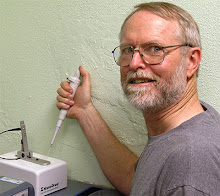A recent paper, referenced below, shows that in a collection of samples
 from the pancreases of individuals that had been diagnosed with type I diabetes less than one year prior to the sampling, insulin producing cells are also infected with enterovirus. The same association between enterovirus infection was found to a lesser extent in type II diabetics, but not in non-diabetic controls.
from the pancreases of individuals that had been diagnosed with type I diabetes less than one year prior to the sampling, insulin producing cells are also infected with enterovirus. The same association between enterovirus infection was found to a lesser extent in type II diabetics, but not in non-diabetic controls.Enteroviruses have been repeated associated with diabetes over the last decade and antigenic determinants of the enterovirus protein coat also bind, i.e. cross react, with antigenic determinants of human cellular proteins.
I examined the enterovirus coat protein, VP1, and found the same three amino acid sequence (three basic amino acids, lysine [K] or arginine [R], highlighted) that I also found in all allergens (peanut, ragweed, dust mite, bee venom) and autoantigens of autoimmune diseases (lupus, MS), and is associated with heparan sulfate-based internalization and presentation of protein immunogens. This observation is consistent with my hypothesis that inflammation plus the presence of one of these proteins, results in production of B and T lymphocytes specific for antigenic determinants on the surface of the immunogen protein. Note that the antigenic determinants usually do not include the three basic amino acid sequence, e.g. RRK, that is involved in uptake and presentation of the protein.
VP1 [Human enterovirus B]
HVINYHTRSESSVENFMGRAACVYIAQYATEKVNDELDR
YTNWEITTRQVAQLRRKLEMFTYMRFDLEVTFVITSSQR
TSTTYASDSPPLTHQVM
reference:
Richardson SJ, Willcox A, Bone AJ, Foulis AK, Morgan NG. 2009. The prevalence of enteroviral capsid protein vp1 immunostaining in pancreatic islets in human type 1 diabetes. Diabetologia. Mar 6. [Epub ahead of print]


